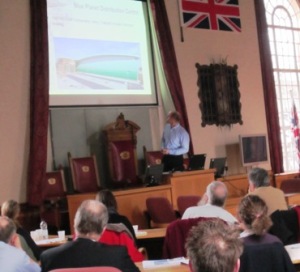PeterboroughBuildingsinNeed
The three presentations were:
Linking the Heritage of the Past to Sustainability for the Future: Professor Chris Baines, (notes below)
Judging Significance in the Historic Environment: The Importance of Conservation Statements and Impact Assessments: Peter Rawlings (presentation below)
Sustainability and Historic Builds: The Practicalities and Options Dr Andrew Turton, Specialist advisor, AECOM Sustainable Development Group (presentation below)
‘Linking the Heritage of the Past to Sustainability for the Future.’: Professor Chris Baines
Summary by AK.
Introduction:
Need to see partnerships across sectors to deliver sustainable solutions, brokering between natural and built environment organisations.
Heritage Lottery Fund funding can be behind this kind of working, especially in projects which pay for the processes, learning and skills as well as projects which pay for new things. The amount the Heritage Lottery Fund have to give has gone up but it has also got more competitive.
There are two key issues that underpin conversations on sustainability:
1) Climate Change – a serious influence on the way we deal with resources.
2) Population and quality of life – addressing sustainability as an issue for urban dwellers
This focus on the urban has been a long time coming, there has been a sense that the environment is the stuff on the outside of town, beyond the edge of the city.
There is a direct relationship between the physical environment and the local climate and collaborative knowledge in this sector is important. This interface can break down as with flooding, which makes big global issues locally relevant, making the links between human interest and the environment much more important. Both drought and flooding highlight that the environment is all pervasive to everyday life.
There have been graphic images across the media such as that of a flooded Leamington Spa. A counterpoint to hosepipe bans and hosepipe warnings, floods highlight a landscape unable to retain water due to its impervious nature, creating a crisis. Climate change is the catch all but there are other aspects to this problem.
What captures the political imagination? It is important to see what we can just get on with now rather than waiting for the effects of climate change to galvanise us.
The link to the historic environment can be seen in places likeTewksburywhere the abbey remains above the water level, it is well positioned, a clear lesson from the past on where to locate buildings. We should disregard this lesson at our peril. This image of the abbey above the floodwaters should adorn every planning office wall!
In Seoul in South Korea the man highway had a problem of traffic congestions, and they needed a flagship project. They removed the highway to reveal the river below, creating green space throughout the city with kingfishers and herons in the heart ofSeoulagain. You can reinvent the relationship between urban living and the built environment.
Peterboroughis susceptible to flooding, in the past places were built in the awareness that they would flood. 1/3 of people in the world live in a zone affected by rising sea levels. How do you change these threats into an opportunity? It is possible to look at the historic use of the land to work out. There can be the creation of attractive wetland systems to absorb the pressure, this sustainable development will be rich in wildlife, and allow people to reconnect and reengage with nature.
The Hamptons in Peterboroughare a place that has thought laterally about travel and journeys, with footpaths and cycleways. It is important not to be distracted by the carbon element of travel by foot or bike, the speed of movement helps to recreate relationships, you can meet neighbours whilst walking and talking. There is something very fundamental about that. The social dimension is more important in terms of sustainability, it is a core part of what needs to be addressed. The Hamptonsshould be marketed as somewhere to grow up and grow old, it strengthens a local life support.
The idea of the last great environmental movement was that cities are intolerable and unhealthy unless you have access to air, e.g. a park. Quality of environment is linked to public health. You need to bring nature to people as well as people to nature. Escaping to trees delivers great benefits, such as stress release in four minutes from being in a green environment. You need immediacy of access, a quality of interface without a sterile environment.
Research has shown that daily access to green spaces has direct benefits to many people, including the retired and elderly. People need daily access to the changing seasons. For example see the monastery inUmbriawith shade gardens on the roof. This relationship is understood by people but not by the planning process. The countryside close to home shouldn’t just be a country park, but should deliver other products, such as species rich environments, food, dairy farming, fishing and leisure. The focus on buying local food is an aspect of this.
Interesting that in Peterborough, most famous for its bricks, there are a considerable number of buildings made of stone, a political statement on the importance of these buildings. Need to connect the buildings to their local landscape by using local materials.





Discussion
No comments yet.